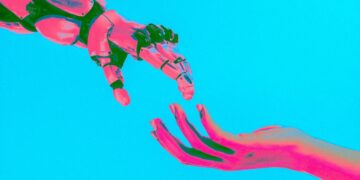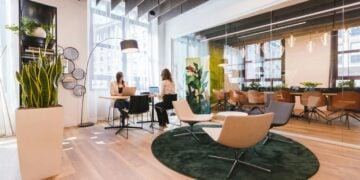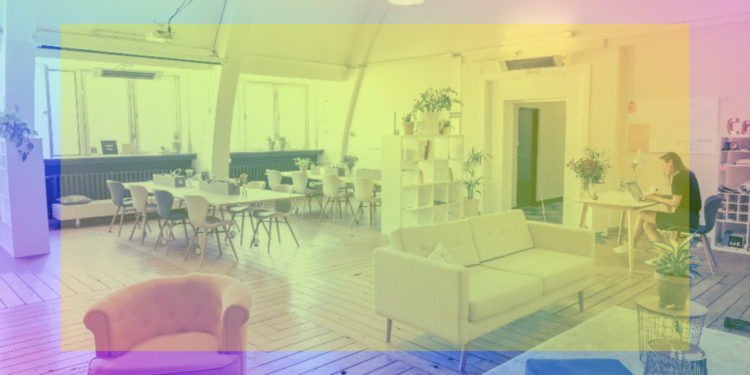- The physical environment is only one aspect of the total experience of a worker.
- Because of workplace decentralization, the role of technology and human resources in workplace design has expanded significantly as design teams and clients strive for a cohesive workplace experience.
- Today, design teams often include additional consultants to achieve project goals, so here’s a list of the specialists needed to develop a cohesive workplace experience.
This article was written by Michelle Reyman and was originally published on Work Design Magazine.
Workplace design has become increasingly complex, and the pandemic significantly accelerated the technology-assisted evolution of the workplace. Hybrid workplace design, while not an entirely new phenomenon, has taken over the market as a dominate strategy.
Both clients and designers now struggle with managing the complexity of the hybrid approach and determining the right solutions for their projects. Along with the complex demands of a hybrid work environment, we have seen social and environmental justice emerge as another layer of consideration in workplace design. For many client organizations environmental, social, and governance (ESG) assessments are further influencing the goals for design projects.
Starting with hybrid workplace design, we find it helpful to frame the concept of the workplace not as a physical space but as an experience. The physical environment is only one aspect of the total experience of a worker.
Because of this workplace decentralization, the role of technology and human resources in workplace design has expanded significantly as design teams and clients strive for a cohesive workplace experience.
Historically, a typical project team consists of the architectural/interior design team, mechanical/electrical/plumbing engineers, structural engineers, civil engineers, lighting designers, acoustic designers, audio-visual design, IT (information technology) and communications designer, and sustainability consultants.
To capture all the factors that impact the employee’s workplace experience, the pool of specialists has grown. Today, design teams often include additional consultants to achieve project goals. Below we’ll review some of the specialists we often rely on to develop a cohesive workplace experience.
Workplace Strategy & Change Management
The term “workplace strategy” has exploded in use over the past few years. Workplace strategy is the process of engagement with an organization to understand their needs and goal(s) and develop a strategy for achieving those goals by way of the workplace experience.
A workplace strategist can be a critical team member for the project and should be brought into the project at inception. The strategist will engage with stakeholders at various levels of the organization to understand issues that may impede or enhance the organizations’ ability to achieve their operational and/or performance goals.
The strategist’s objective is to define organizational goals and create buy-in to an overall strategy for achieving those organizationally defined goals. They utilize consensus building exercises to align stakeholders across the organization and will work with a change management consultant to facilitate change in the organization. Not all the recommendations they develop will be specific to the built environment.
Their strategy recommendations can include anything that shapes the workplace experience: human resource policy, culture, technology integration, communications, management, data collection, physical workplace, even the home environment.
A change management consultant takes a structured approach to guiding organizations through change, often using the Kubler-Ross stages of grief as the model for how individuals process change. The change management consultant works with the project team to develop and implement a change management plan which typically includes engagement events such as town hall meetings, site tours, status updates and educational sessions on how to use the tools embedded in the new workplace experience design. Training, often overlooked in traditional projects, is of the utmost importance to project success.
Sustainability & Wellness
The range of sustainability certifications available (for programs such as WELL Building Standard, LEED, Fitwel, Green Globes, etc.) and the need to monitor carbon impact on projects has generated a field of sustainability consultants, certification professionals., and specialists in energy modeling, commissioning, and carbon impact assessment.
Before the team engages a specialist, however, it’s important for the project team to understand the organization’s sustainability goals and how the project can support those goals. A sustainability consultant can help guide the discussion around priorities and advise on the best path forward. In some cases, the goals of the organization may require moving beyond the confines of a specific program to innovative approaches that aren’t yet captured by an established certification.
Wellness has emerged as a new focus. Most sustainability certifications concentrate on energy consumption and carbon impact, making individual well-being a secondary element. The WELL and Fitwel certification programs were developed to bridge the gap between sustainability and wellness. Others have followed.
Like building sustainability certifications, wellness certifications follow specific criteria that may not perfectly match a project’s goals. Additionally, most building certification systems fail to address the current hybrid workplace experience. A consultant specializing in wellness can help to navigate the best path for achieving the organization’s goals.
IoT Integration & Reporting
The integrated sensor technology in “smart buildings” enables owners and operators to track energy usage, water usage, occupancy rates, lighting use, as well as security, and control and automate various systems and services. The growing use of IoT (internet of things) technology in commercial buildings has yielded a complex network of systems communicating over various platforms within the office environment. For employers, IoT technology means the power to capture data on space use as well as integrated control of various systems.
Because these systems utilize proprietary platforms and collect information, security is a concern. Often those platforms communicate with cloud-based servers outside of the client’s security network, potentially leaving the organization’s data vulnerable to unauthorized access. In many cases, the various systems required to achieve the project’s goals can’t easily communicate with each other, limiting system functionality. The below image provides an illustration of the complexity of systems within a single project.
The design team should consult with an integration specialist who can help the project team develop a program of requirements and guide systems selection and integration in line with project goals.
Diversity & Inclusion
DEI (diversity, equity, and inclusion) initiatives have come into focus in recent years in ways that go beyond the tradition focus on minority and gender focused recruitment. Inclusion has become a focus on workplace experience projects that utilize a hybrid work structure. Some of the concerns that come from the hybrid workplace design structure include:
- Equitable participation in hybrid meetings
- Technology interfaces that can be utilized across generations and ability levels
- Physical workplace environment that accommodates individuals of varying ages, mobility, neurological profiles, vision and hearing difficulty, and cultural experiences
Universal design strategies have grown in popularity in recent years. In universal design, the focus moves beyond meeting basic ADA (Americans with Disabilities Act) requirements to creating a more equitable environment for everyone.
While project teams may be familiar with the basic concepts and strategies incorporated into universal design, a consultant can advise on specific solutions and help navigate any potential liability issues that come with a design solution.
Audiovisual and technology consultants that specialize in inclusive design can help to determine systems and processes for technology use that allow for more equitable experiences among the organization’s employees. They can advise on technology solutions that facilitate a positive user experience both remotely (work from home) and within the office environment and suggest tools that allow for hybrid collaboration to be more inclusive, such as closed captioning use on virtual calls.
Cultural experiences can also play a significant role in an individual’s workplace experience. In organizations that span different cultural backgrounds it is critical that the project team address the varying ways in which those cultures impact the workplace experience.
For example, for an organization with offices that span multiple continents, a one-size-fits-all approach to space design could create scenarios that are offensive in some locations. Behavioral scientists have increasingly become critical team members in designing cultural awareness into the workplace experience.
Bringing It All Together
Managing the array of consultants required for a complex workplace design project is no easy task — evaluating the potential of each consultant and fitting them into the project schedule while setting client expectations. But we’ve identified some best practices regarding the schedule for consultant integration.
Every hybrid workplace design process is different, requiring customized solutions befitting organizational culture, goals, and of course, budget. Each team will need to weigh the importance of various considerations on the project and the clients’ project goals. The above illustration provides a potential timeline for integration of consultants.
When feasible, we recommend a discussion with the client on the role of each consultant to reach a mutual understanding on the most advantageous project team structure. That will help ensure that the project starts on a strong footing.


 Dr. Gleb Tsipursky – The Office Whisperer
Dr. Gleb Tsipursky – The Office Whisperer Nirit Cohen – WorkFutures
Nirit Cohen – WorkFutures Angela Howard – Culture Expert
Angela Howard – Culture Expert Drew Jones – Design & Innovation
Drew Jones – Design & Innovation Jonathan Price – CRE & Flex Expert
Jonathan Price – CRE & Flex Expert
























